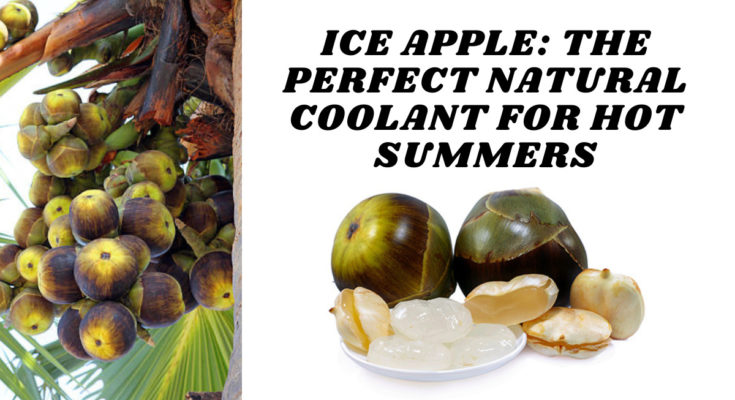ICE APPLE
Ice apple, also known as palm fruit or taal fruit, is a tropical fruit that grows on the Palmyra palm tree (Borassus flabellifer). It is mainly found in Southeast Asia and is commonly consumed in countries like India, Sri Lanka, and Thailand.
The ice apple has a round shape and a brownish exterior. When mature, it is filled with a translucent, jelly-like pulp that is sweet and refreshing. The taste is often described as similar to coconut water or sugarcane juice.
To eat an ice apple, you typically crack open the outer shell and scoop out the soft pulp. It is usually consumed fresh, and sometimes used in drinks, desserts, or as a natural sweetener in various dishes.
Ice apples are a good source of hydration as they contain a high amount of water. They also provide some essential nutrients such as vitamin C, B vitamins, and minerals like potassium and iron.
It’s worth noting that the term “ice apple” may also refer to a popular dessert made with ice cream and apple slices. However, this usage is less common and can vary regionally.
HEALTH BENEFITS
Ice apples, or palm fruits, offer a few potential health benefits:
1. Hydration: Ice apples have a high water content, making them a refreshing and hydrating fruit. Adequate hydration is essential for maintaining bodily functions and overall health.
2. Nutrient content: Ice apples contain several essential nutrients, including vitamin C, B vitamins (such as thiamine and riboflavin), potassium, and iron. These nutrients play various roles in supporting overall health, such as supporting the immune system, promoting energy production, and maintaining healthy blood cells.
3. Antioxidants: Ice apples contain antioxidants that help protect the body against oxidative stress and reduce the damage caused by free radicals. Antioxidants are associated with various health benefits, including reducing the risk of chronic diseases like heart disease and certain types of cancer.
4. Natural sweetener: The sweet taste of ice apples can make them a natural alternative to refined sugars. Using ice apples as a sweetener in recipes or drinks can potentially help reduce added sugar intake, which is beneficial for managing weight and preventing conditions like diabetes.
It’s important to note that while ice apples offer certain health benefits, they should be consumed as part of a balanced and varied diet. Individual nutritional needs may vary, so it’s always a good idea to consult with a healthcare professional or a registered dietitian for personalized advice.
NUTRITIONAL VALUE
The nutritional value of ice apples (palm fruits) can vary slightly depending on factors such as ripeness and growing conditions. Here is a general overview of their nutritional composition per 100 grams:
- Calories: Approximately 81 calories
- Carbohydrates: Around 20 grams
- Protein: About 1 gram
- Fat: Negligible amount
- Fiber: Roughly 1 gram
Ice apples are also a good source of various vitamins and minerals, including:
- Vitamin C: Provides approximately 22% of the recommended daily intake.
- Thiamine (Vitamin B1): Contains a small amount.
- Riboflavin (Vitamin B2): Provides a minimal amount.
- Niacin (Vitamin B3): Offers a small amount.
- Potassium: Contains about 229 milligrams.
- Iron: Provides approximately 1 milligram.
Please note that these values are approximate and can vary based on the specific variety and growing conditions of ice apples.
USES
Ice apples (palm fruits) can be used in various ways:
1. Fresh consumption: Ice apples are commonly consumed fresh. They can be cracked open, and the translucent, jelly-like pulp can be scooped out and eaten as is.
2. Juices and smoothies: The sweet and refreshing pulp of ice apples can be blended with water or other fruits to make juices or smoothies. It can add a unique flavor and enhance the nutritional profile of the beverages.
3. Desserts: Ice apples can be used in desserts like puddings, ice creams, sorbets, and fruit salads. Their natural sweetness and jelly-like texture can add a delightful element to these treats.
4. Sweetener: The juice extracted from ice apples can be used as a natural sweetener in various dishes and beverages. It can be an alternative to refined sugar, providing a unique flavor profile.
5. Traditional preparations: In some cultures, ice apples are used in traditional dishes and preparations. For example, in certain regions of India, ice apple pulp is mixed with jaggery (unrefined sugar) to make a sweet delicacy called “nongu paal.”
6. Fermentation: In some cases, ice apples are allowed to ferment, and the resulting product is used to make alcoholic beverages like palm wine or toddy.
The uses of ice apples can vary depending on regional culinary traditions and personal preferences. Experimenting with different recipes and preparations can help you discover creative ways to enjoy this tropical fruit.



